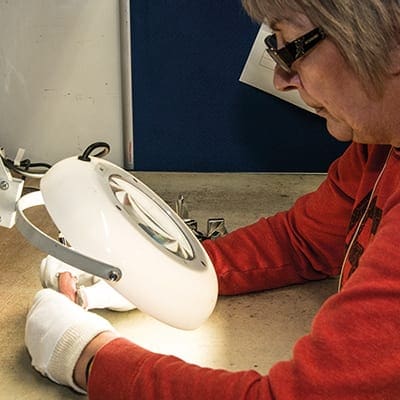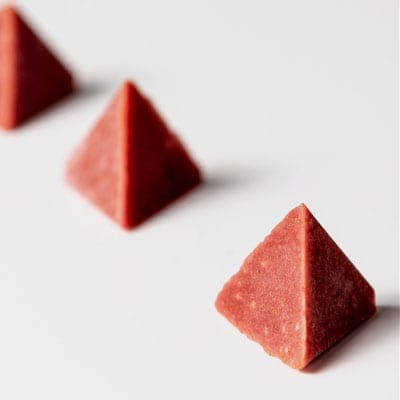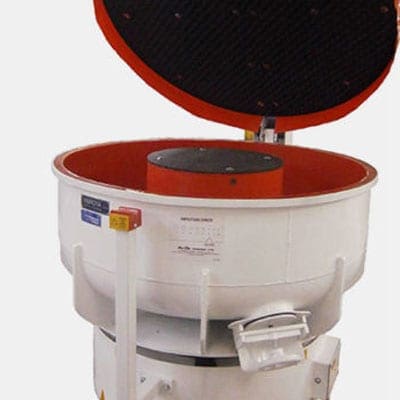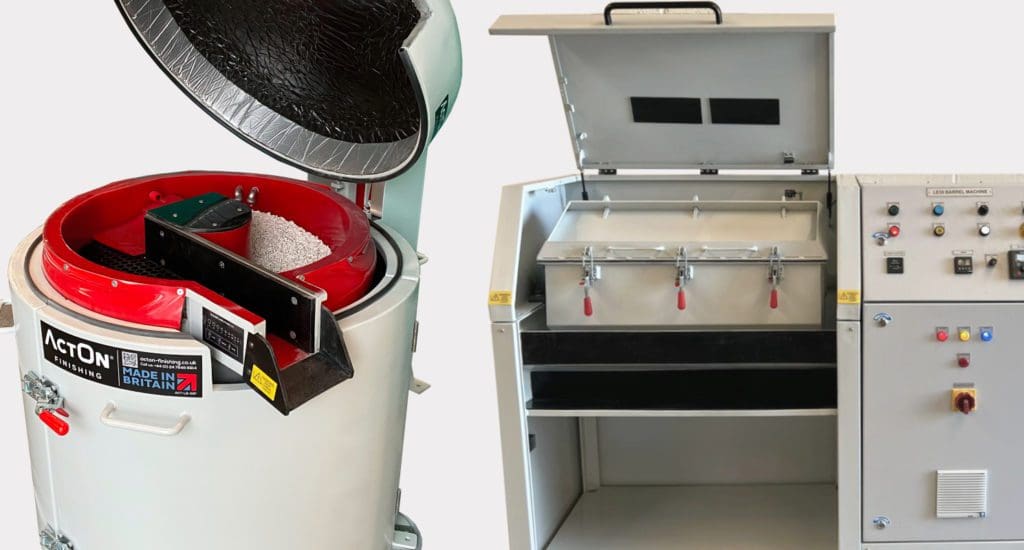
Mass finishing offers the ability to cost-effectively finish large quantities of parts at one time.
The most common types of mass finishing are tumble finishing and vibratory finishing for applications such as deburring, cleaning, radiusing, de-flashing, descaling, polishing, dust removing or surface smoothing.
In this article we are going to unpack what these are and the differences between them; the advantages and disadvantages of both methods and recommend which techniques will best fit your finishing requirements.
What is Tumble Finishing?


Tumble finishing, also referred to as Barrel finishing, is a batch-type finishing process. It allows small components to be deburred, cleaned, radiused, de-flashed, de-scaled, polished and brightened. Tumble finishing machines are also great at removing rust from metals and smoothing the part’s surface. The process includes finishing the parts in a mix of media, compound and water.
During the tumble finishing process, the barrel rotates the mix of media, compound, water and parts. The rotation of the barrel causes this mix to tumble down upon itself causing friction and thereby abrading the parts in the mass.
What is Vibratory Finishing?
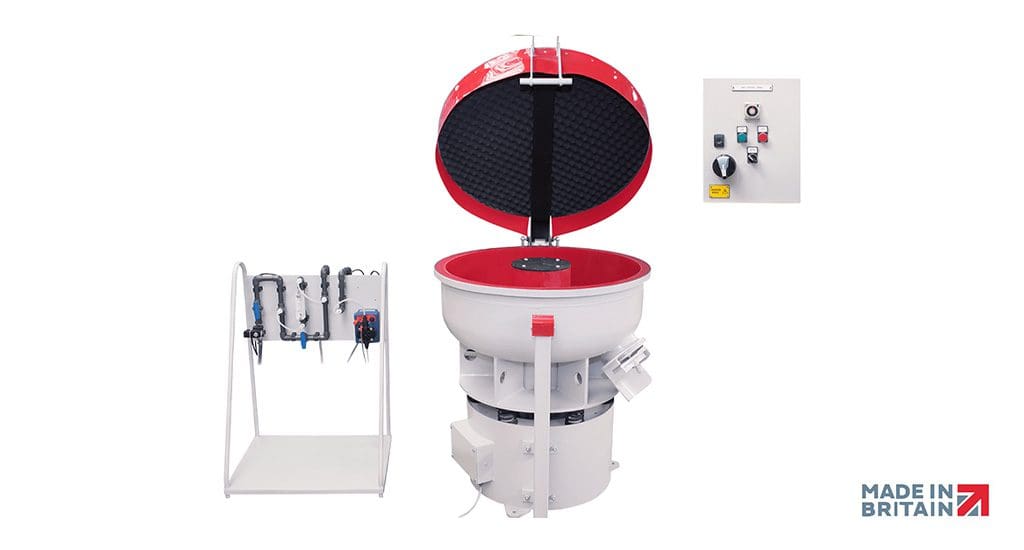

Vibratory finishing is a mass finishing process that automates the mechanical and chemical finishing of various shaped parts. Using this finishing method helps you achieve various applications from deburring, descaling, radiusing and cleaning to polishing and surface improvement. This is a stage in the manufacturing process of components, which allows small to large numbers of parts to be finished simultaneously. A combination of media, parts and compound are placed in a vibratory finishing machine (like bowls, duals or troughs).
During the vibratory finishing process, the vibrations cause the contents to move in a circular motion and the media to grind against the part to get the desired finish.
The processes can be configured as a batch system or a continuous system. Parts that are processed using a batch system will be loaded into the machine, processed and unloaded before the next batch is ready. The continuous system is a process where the parts are loaded at one end, and come out at the other end in the finished condition.
The differences between the two mass finishing types


There are quite a few differences between tumble finishing vs vibratory finishing. Firstly, vibratory finishing machines can be automated unlike tumble finishing machines, which is why vibratory finishing machines are considered more cost and time effective.
When comparing the two it’s also important to understand that vibratory finishing is a much more complex process in both its operation and features. This has an effect on the cost of the equipment, which is much more expensive compared to tumble finishing. This is something that should be considered when weighing up tumble finishing vs vibratory finishing, however to contrast the expense of vibratory finishing, tumble finishing equipment, although cheaper, takes longer to process components.
Additionally, vibratory finishing processes can result in a smoother finish, without causing excess surface wear, increasing the durability of a part and extending the lifespan. Compared to tumble finishing, the clue is really in the name, the parts tumble onto one another, and increase the risk of surface indentations.
The advantages and disadvantages of tumble finishing vs vibratory finishing summed up:
Advantages of Vibratory Finishing?
- Machines can be automated – more cost and time effective
- Machines process components a lot quicker
- Smoother finish without excess surface wear
- Can be used as a batch and continuous process
- Can be used as a media and compound process or part-on-part process
- Can be used on a wide range of materials (from hard metals to polymers)
- Based on parts geometry, you can chose between a bowl or a trough. Long and irregular shaped parts are more suited to be finished in the trough machine
- The vibratory dual machine offers the option to carry out wet and dry processes
- It offers a quiet operation
Disadvantages of Vibratory Finishing?
- Media wears more rapidly in this machine
- Complex process
- Equipment is expensive
Advantages of Tumble Finishing?
- Equipment is cheaper
- Less wear on the abrasive media
- It is better suited for smaller batches of components
- Tumble finishing is a coarser process that produces rounded-off corners
- It is more suitable for foundry castings and parts with heavy radii
- Barrel machines are better for finishing tougher materials and hard metal pieces that need heavier action to remove imperfections.
Disadvantages of Tumble Finishing?
- Increased risk of surface indentations as parts tumble onto each other
- Longer to complete the finishing task
- Not compatible with automation


What do we recommend at ActOn?
Generally, we would recommend the vibratory finishing process as it can be used for more finishing applications, it has a gentle action on parts and the process time is much shorter.
Nonetheless, choosing a mass finishing method depends on the customer’s finishing requirements and the part’s initial condition. For this reason we always recommend carrying out a finishing trial to determine the best finishing machine and consumables. We know this as we always carry out our own finishing trials.
It’s clear that both mass finishing methods have their advantages and disadvantages, finding out what’s best for you and your finishing needs is what will help you determine which method you should use. At ActOn our knowledge and expertise can be trusted to help you choose the best tumbling or vibratory finishing system.
Contact us to learn more about our extensive range of finishing equipment and our services.
FAQs
What is a vibratory finishing machine?
As a common finishing method in the manufacturing industry, vibratory finishing is an efficient process used to optimise all types of small products and parts. Vibratory finishing machines help you clean and deburr products at a faster pace.
What is vibratory deburring?
Vibratory deburring removes the rough edges from parts and enables them to fit together more efficiently. This leads to fewer part rejections as well as improved safety. In addition, deburring is an important step in preparing parts for painting.
How does vibratory polishing work?
In this stage a combination of media, parts and compounds are placed in a vibrating machine. The vibrations cause the contents to move in a circular motion and the media to grind against the part to get the desired finish.
What is a tumbling barrel?
Barrel finishing, also known as barrel tumbling or vibratory finishing, is a surface improving operation in which a mixture of parts, media and compounds are placed in a six- or eight-sided barrel and rotated at a predetermined speed for the purpose of rounding corners, deburring, grinding, descaling, deflashing, improving surface finish and much more.
What are the different types of finishing?
There are several types of metal finishing such as metal plating, chemical finishing or coating, grinding, buffing, electroplating, and sandblasting. Each process has basic steps with all processes beginning with surface preparation. Metal finishing processes can include anything from technical processes to buffers.







